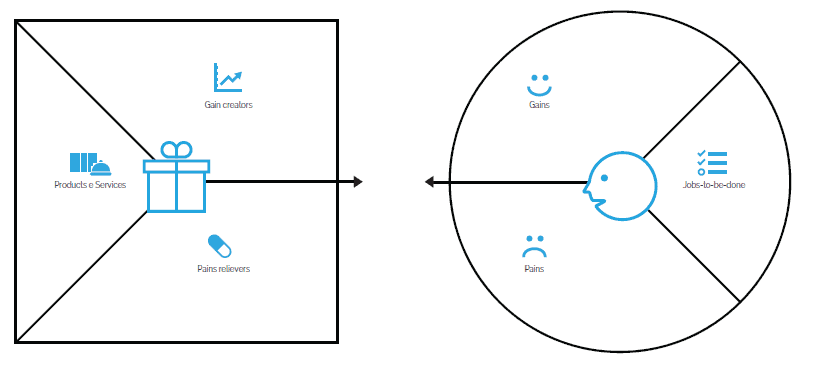What is a Value Proposition, How to Create One, and 13 More Examples
What Determines Whether a Consumer Will Choose Your Brand Among So Many in the Market?
When a consumer comes across a solution offered by your company or a communication designed to promote it, the value proposition reinforces that this option, and no other, is the best choice to solve what the consumer is looking for.
A value proposition must be clear, strong, and consumer-focused.
This is how your business’s marketing will stand out from the competition, especially if your brand is just starting and is not yet well known.
If you want to learn more about what a value proposition is, its strategic importance, and how to define a proposition that ensures a strong brand positioning, keep reading this post!
What Is a Value Proposition?

A value proposition is a promise to be delivered.
In a clear and concise way, it defines what your company or brand has to offer.
It is the main reason why a consumer should buy from you.
A strong value proposition should be a clear statement that offers relevance, benefits, and differentiation.
This way, your brand ensures a strong market positioning and engages the target audience.
Why Is the Value Proposition Important?
It is through the crafted and presented value proposition that the consumer decides whether or not to make a purchase or close a deal.
If, when interacting with any material, website, or sales team of the company, the consumer does not clearly understand the benefits and differentiators of the product or service, the sale is lost.
Therefore, defining your company’s value proposition and using it in your communication is essential to show consumers what you have to offer.
By applying this strategy, you save time and resources.
🔎 Read also: Unique Selling Proposition: What It Is, Its Advantages, and How to Create One
What Are the Key Aspects of a Value Proposition?

To build your value proposition, you must consider fundamental components.
This way, you will craft a solid statement capable of engaging your audience.
- It must be easy to read and understand: One of the most important points of a good value proposition is that it must be easily understood. If your message is unclear and the reader has to struggle to comprehend it, your value proposition is not well-structured.
- It must use the right language: As mentioned earlier, the value proposition should focus on the consumer. Therefore, to reach this audience, it must use the appropriate language. To build the right tone, you can conduct customer interviews and invest in strong copywriting.
- It must be transparent: The proposition must reflect what your company or product actually delivers. By being honest and transparent, you will gain the consumer’s trust, as they will know exactly what to expect once they become a customer.
- It must be action-oriented: Besides clearly presenting the solution and benefits while using the right language and building trust, you should also guide the reader toward an action or make it clear what they will find when they contact the company.
How to Create a Value Proposition?
Your brand’s value proposition should answer fundamental questions such as:
- What product or solution does your company offer?
- What is the ultimate benefit obtained from the purchase?
- What type of consumer benefits from doing business with your company?
- What makes your offer unique compared to your competitors?
In addition to answering these questions, you can use the tips we’ve selected to build a strong value proposition.
🔎 Read also: How to Do Cross-Branding and Co-Branding? Complete Guide and 7 Examples
Know Your Target Audience
The first step is to deeply understand who the consumer looking for your brand’s solution is.
The value proposition is always focused on solving this need. If you do not know your audience, you will not know what they are looking for or how they make their purchasing decisions.
Don’t rely solely on assumptions or superficial impressions—conduct research with current customers or potential consumers to obtain accurate insights.
Study the Competition
In addition to focusing communication on the consumer, the value proposition must highlight what differentiates you from competitors.
If your focus is on the same differentiator as competing companies, your positioning will be weakened.
Identify your competitors and analyze how they communicate their value propositions.
Remember, your company’s communication must be different and better to establish a strong market presence.
Use a Structured Approach
A value proposition typically consists of a text block and a visual component.
There is no single formula for structuring a value proposition, but we suggest the following framework:
- Headline: The headline of your value proposition should be a short, attention-grabbing phrase that highlights the ultimate benefit your solution offers. You may also mention the product and/or target customer.
- Subheading: The subheading or short explanatory text following the headline should be brief. Use one to three sentences to explain what your company offers, who it serves, and how the solution helps solve a specific problem.
- Bullet Points: Use bullet points to make the value proposition more visual and concise by listing the main benefits or features of your product or service.
- Images: Images convey information faster than articles. Use product photos, images of people representing your customers, or visuals that reinforce the message of your brand’s value proposition.
Highlight Product Benefits
How will your solution improve the customer’s routine or life?
This must be clear in your company’s value proposition.
After all, that’s why the potential customer is there—to buy or hire something they need.
If they are not immediately impacted by the benefit, you will likely lose their attention and, ultimately, the sale.
Present It in Multiple Ways
Your value proposition should not appear in only one form within your brand’s communication.
Instead, it should guide marketing across all content and be adapted for different formats across all company channels.

What Are the Different Types of Value Propositions?
Some types of value propositions stand out by focusing on the benefits they offer.
Using this strategy can make it easier to start crafting your brand’s proposition.
Here are some of the most commonly used value proposition types by companies.
- Performance: A hook widely used by the technology and electronics sector, improving performance or ensuring proper functionality is explored as an applied value.
- Innovation: If your company offers a solution that does not yet exist in the market or a new take on an existing solution, make sure to highlight this in your brand communication. People love innovation! A great example of a brand that effectively leverages this type of differentiation is Apple with every new launch.
- Customization: Consumers like to feel special and to acquire personalized products or services. If your product is adaptable to individual needs, don’t miss the opportunity to highlight this in your value proposition.
- Design: When we talk about highlighting design as part of the value proposition, we’re not just referring to products with an innovative aesthetic. Design is related to everything that enhances the user experience. If your product or service possesses this attribute, it should be clearly communicated.
- Problem-Solving: Solving problems means saving your customers time, resources, and effort. This type of solution is among the most sought-after today. Companies offering specialized software and consulting services are examples of businesses that use problem-solving as their value proposition.
- Status: Many consumers aspire to own products and services that represent status in our society. If your product fits this category, this hook can also be explored in your value proposition. Some examples include luxury car brands, high-end real estate developments, and premium imported perfumes.
- Price: For another group of consumers (typically opposite to those who buy for status), price is a major decision factor when choosing a brand. If price or payment options are key differentiators for your brand, include these points in your value proposition.
- Cost Reduction: Similarly, cost reduction is highly valued, especially when it comes to solutions and products designed for businesses. Online meeting tools are great examples of brands leveraging this type of value proposition.
- Risk Reduction: This is an excellent approach for companies working with security, such as online payment solutions and credit and debit card services. If your solution minimizes the risks of an operation, use this as a key focus in your communication.
- Accessibility: This can refer to price accessibility, but it can also mean making a product available to a broader audience that previously couldn’t access it—whether the general public or specific groups.
- Convenience: The accommodation rental platform Airbnb is an example of a brand that uses convenience as its value proposition. The urban transport platform Uber is another. Whether through ease of use, competitive pricing, or widespread availability, convenience can be a strong selling point.
🔎 Also read: Gamification in Marketing: The Most Comprehensive Guide You'll Read on the Subject
What is a Value Proposition Canvas and How to Use It?

A Value Proposition Canvas is a tool that helps define and create this strategic aspect of a business.
It is an in-depth component of the Business Model Canvas.
It takes into account factors such as the consumer profile and the solution profile. Each point should be evaluated and balanced, following the model below.

Once the description is complete, it becomes easier to determine the focus of the value proposition to be developed.
This allows for better alignment between customer needs and desires with the benefits offered by your brand.
Value Proposition Examples
To make this article even clearer and more engaging for those looking to create or refine their value proposition, we’ve brought some examples.
Apple – “The Experience is the Product”
Apple is an electronics company that incorporates several of the value proposition elements mentioned earlier: innovation, status, and design.
They stand out in the most innovative electronic devices and offer a range of services to their customers.
In other words, the brand’s value proposition is not just the products themselves but the experience that comes with them.
Apple’s key differentiator is how consumers transform after accessing their products—the goals they can achieve using them.
People buy from Apple to feel different, enjoy the experience, and this directly impacts sales.
Google Meet – Video Calls for Everyone
Specific products within a brand can also have their own value proposition.
This is the case with Google Meet.
The tool offers accessibility, security, and problem-solving for those who need to conduct video conferences in a simple and efficient manner.
That’s exactly what represents Google Meet’s value proposition—it aims to connect people by removing barriers, such as:
- Paying for video call programs
- Connection issues
- Configuration difficulties
- Lack of availability
- Low accessibility
- And more
As a result, the platform has gained increasing numbers of users, especially after the Covid-19 pandemic.
Starbucks – “Every Day, a Customer Receives a Beverage from a Starbucks Barista”
Starbucks’ value proposition revolves around selling a customizable product in a cozy environment, with a focus on service and quality.
Consumers aren’t just buying coffee—they’re buying an experience.
Uber – “The Best Way to Get Around”
Uber, which started solely as a transportation service, now also delivers food and packages.
When we talk about Uber’s value proposition for its passengers, we’re referring to convenience and efficiency in transportation.
The brand identified the problems consumers faced—high prices, long wait times, limited options—and positioned itself as the solution.
This strategy works because it combines utility with convenience, benefiting customers.
Slack – “Be More Productive at Work with Less Effort”
Slack is a messaging app that also boosts employee productivity.
Its value proposition is immediately clear: you can communicate with colleagues, share files, integrate with other tools, and even make calls—all in one place.
Slack effectively solves the primary communication challenges faced by remote teams.
Beyond that, it creates even more opportunities for interaction for those who can’t be in the office.
There are hundreds of instant messaging apps, but Slack’s value proposition—reflected in its usability and design—helped solidify it as the best of all.
HubSpot – “A CRM That’s Easy to Use”
The statement speaks for itself.
HubSpot provides an easy-to-use CRM software designed to help organize your business, align data, and track everything closely.
This value proposition works because HubSpot truly caters to those who don’t want to deal with complex, difficult-to-navigate systems.
To fully understand this value proposition, we need to think back to HubSpot’s early days when it was still a startup in Boston.
Back then, marketing efforts were fragmented—mixing offline and online, spreadsheets with analytics, real data with assumptions.
HubSpot paved the way for the CRM market and served as inspiration for RD Station in Brazil.
“A CRM That’s Easy to Use” is more than just a statement. HubSpot didn’t just create a CRM; it defined what a CRM should be and introduced a complementary business philosophy: inbound marketing.
Cloudflare – “Helping Build a Better Internet”
Not every value proposition is effective.
Cloudflare’s slogan, “Helping Build a Better Internet,” is an example of a vague statement that doesn’t clearly communicate its value to users.
This highlights the importance of making your value proposition specific, not overly broad or idealistic.
Think carefully about what your company truly offers and how it impacts consumers.
Nike – “Where Athletes Belong”
Like all of Nike’s marketing campaigns, its value proposition is also inspiring.
Even though the phrase is “Where Athletes Belong,” you can see that anyone can be part of this place—all it takes is becoming a member of the brand.
It’s a promise. You may not be an athlete today, but with Nike, you will always be one.
Beyond that, this statement reinforces how much the company values inclusivity, giving consumers the chance to feel more connected.
Grammarly – “Great Writing, Simplified”
Grammarly is the kind of platform that everyone should have. It focuses on reviewing and correcting articles, assisting throughout the writing process.
Well, we can see that its value proposition perfectly sums up what I just mentioned in the previous paragraph, right?
There’s no confusion about what the brand does. In fact, even its name gives an idea of what to expect. That’s why we emphasize simplicity in its usability.
Visa – “A Network Working for Everyone”
In the image below, we can see that the brand uses the term “everyone” three times.
No, that wasn’t a coincidence.
In fact, this structure reinforces the brand’s value proposition, which is truly about serving everyone—consumers, merchants, bankers, and everyone who is part of the network.
And what is this network? It’s a network of people who produce, buy, sell, and operate. It’s the workforce and the consumer market.
In the society we live in, Visa is everywhere. This network is the world. And with Visa, it works for everyone.
Trello – “More Than Work—Teamwork”
Trello is a project management tool that uses the Kanban method to organize tasks.
The brand’s value proposition, “More Than Work—Teamwork,” highlights how the platform allows multiple collaborators to navigate, align tasks, track deadlines, prioritize workloads, and more.
Trello has a collaborative aspect that is essential for any marketing effort. This is particularly important since its primary use is within this very area.
WordPress – “The World’s Most Popular Website Builder”
Well, I don’t think there’s a clearer value proposition on this list than WordPress’s.
The platform boldly claims to be the most popular in the world—and it’s not wrong.
According to a HubSpot study, WordPress powers around 42% of all websites worldwide.
This statement immediately impacts users, making them associate the tool with quality and all the possibilities it offers.
And there’s another side to this: anyone who needs to build a website will also need to manage it.
By positioning itself as the most popular in the world, WordPress signals to future users that they will have access to a vast amount of both official and community support.
Conclusion
You need to create or improve your brand’s value proposition, ensuring it clearly communicates what your company offers and why it’s the best solution for your customers.
Focus on the tips presented in this article, explore effective structures, and test different approaches until you get it right.
Show consumers why they should choose you!








